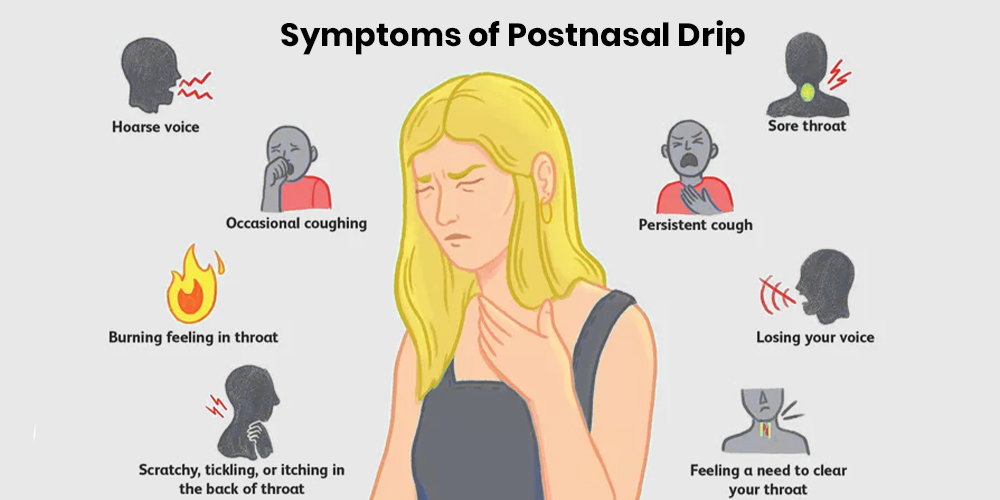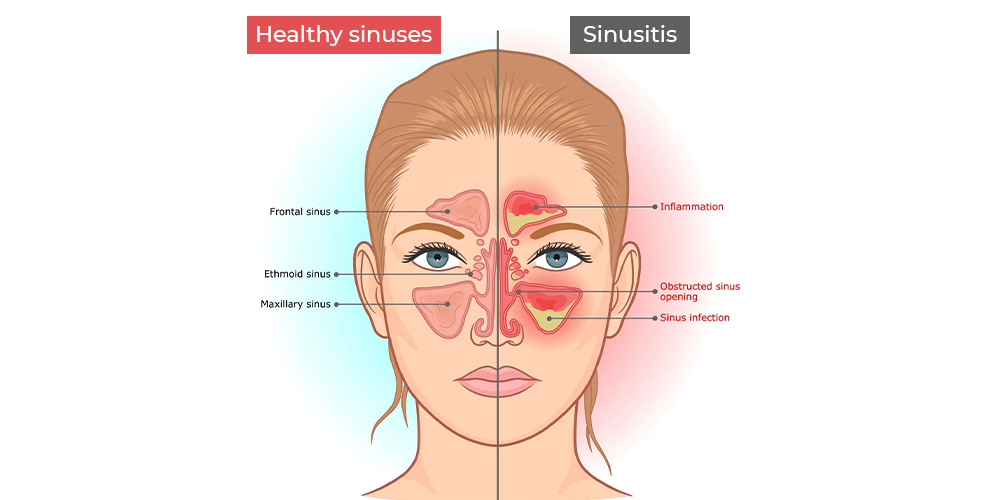What is Chronic Catarrh?
Chronic Catarrh refers to the accumulation of mucus in the back of the nose, throat, or lungs. It is usually temporary and caused by a cold or any allergies. In simple terms, catarrh is referred to as a post-natal drip, when excessive mucus drips back from the nose to the throat.
According to Dr. Mas Takashima, an ENT physician specializing in nose and sinus problems, “It’s not always just a runny nose.” Additionally, symptoms of this condition encompass sneezing, congestion, coughing, and nose irritation. Nevertheless, it isn’t necessarily a serious problem, it can be an unpleasant experience for individuals, and some may endure symptoms that persist for months or even years.
Moreover, affected patients cough because mucus spills into the throat. It can be treated by avoiding the triggers, keeping your nose clean with water rinses, staying hydrated, and taking the medicines your doctor gives you.
Additionally, In this blog, we will learn more about the condition, its symptoms, diagnosis, treatment, and management.
Chronic Catarrh Symptoms
Inflammation caused by allergens like pollen and dust particles plays a vital role in this condition. This causes the nasal passage to swell and accumulation of the mucus. Additionally, sinus infections may reoccur due to weather changes or hormonal fluctuations, even without triggering an allergic response.
Moreover, excessive mucus production and irritation may lead to pain, nosebleeds, and a diminished sense of taste and smell. Some of the common chronic catarrh symptoms include:
Constantly blocked nose
Constant feeling of blockage from nasal congestion makes it difficult to breathe freely through the nose.
Excessive Mucus
Additionally, Chronic Catarrh causes the nose to make excess mucus, which causes a runny nose and a feeling of tightness in the throat and chest.
Mucus Drain
If you have this condition and mucus drains down your throat, it irritates your throat and causes persistent coughing.
Coughing
Continuous coughing is a common chronic catarrh symptom. Remarkably, it is most noticeable in the morning or after sleeping. Subsequently, managing this symptom becomes crucial for a more comfortable daily experience.

Figure: Pictorial representation of symptoms of chronic catarrh
Sore Throat
In this condition, irritation from postnasal drip can cause a persistent sore throat that lasts for a long time and makes it hard to swallow and talk. This persistent sore throat adds to the overall discomfort.
Reduced Ability to Smell and Taste
This can cause inflammation, making it hard to enjoy smells and tastes fully. Additionally, this inflammation can significantly reduce the sense of smell and taste. Consequently, individuals may find their sensory experiences compromised.
Headache and facial pain
If you are suffering from chronic catarrh, you may feel pain in your face and have a severe headache due to blockage of the sinus because of excessive mucus. Subsequently, your head may feel heavy.
What are the Causes of Chronic Catarrh?
The main cause of chronic catarrh is not known, however some of the known causes are listed below. This can be triggered by:
Sinus infection:
Figure: Chronic sinusitis can result from a sinus infection or inflammation of the sinus lining. Moreover, common symptoms involve nasal congestion, making it difficult to breathe through the nose, accompanied by pain and swelling around the eyes, cheeks, nose, or forehead.
- Cold or fever
- Eating spicy foods
- Hormonal changes during pregnancy
- Changes in weather
- Pollution
- Smoke of cigarette
- Allergic reaction to things, such as spray, dust, and toxic particles in the air
- Hormonal changes in the menstruation cycle

How is Chronic Catarrh Diagnosed?
There is no test for catarrh because an actual disease doesn’t cause it. However, allergy, mucus tests, and CT X-rays of the sinuses do help treat people and identify symptoms of this condition.
During the appointment, the doctor will inquire about the individual’s symptoms. The doctor may utilize a small portable flashlight to examine the person’s nasal passages or inspect the back of their throat.
Furthermore, the following potential causes can be investigated:
- Infections caused by germs
- polyps inside the nose
- Gastroesophageal reflux Disease (GERD) or Gastroesophageal reflux (GER)
What are Some Chronic Catarrh Treatments?
The treatment of this condition targets inflammation, symptoms, and causes. Consequently, talking to a healthcare expert is essential for an accurate diagnosis and a personalized treatment plan. Furthermore, here are some standard procedures to treat the problem:
Antihistamines:
Both over the counter and prescription antihistamines can help relieve symptoms caused by allergies by reducing inflammation. Moreover, they offer a practical approach to managing allergic reactions.
Decongestants:
Nasal decongestant sprays or pills can temporarily alleviate congested nasal passages, promoting easier breathing. However, it’s important to note that nasal sprays should be used for short periods to prevent rebound effects.
Nasal Corticosteroids:
The Nasal corticosteroid sprays you are prescribed by your doctor can reduce swelling and mucus production in the nose.
Saline Sprays and Rinses:
Using saline nasal sprays or rinsing your nose with water can help clear mucus and ease congested nasal passages. Furthermore, incorporating saline solutions into your routine can contribute to ongoing symptom management.
Nasal Surgery:
In some cases, surgeries like septoplasty (to fix a bent sinus) or turbinate reduction may improve nasal airflow and reduce chronic inflammation. However, weighing the benefits and potential risks of surgical interventions is crucial before taking any step.
It’s important to remember that different people respond differently to treatments, and using more than one method to treat this condition may be necessary. Additionally, you need to talk to a doctor or nurse regularly to keep track of your progress, change your treatments, and ensure you get the best possible care for your condition.
How to Get Rid of Chronic Catarrh at Home?
While seeking medical advice and using nasal decongestants is beneficial, there are home-based treatments you can explore. Consider the following remedies:
Stay Hydrated:
Drinking plenty of water helps keep mucus thin and easy to get rid of. Consequently, this makes it easier to breathe and reduces congestion and pain.
Nose Irrigation:
Rinse your nose with water and use a saline nasal spray. This can help remove extra mucus and allergens, which can help relieve tightness and swelling.
Inhaling steam:
Inhale steam from a bowl of hot water or a steam device. Furthermore, moisture makes it easier to breathe by wetting and relaxing irritated nasal passageways. Additionally, you can add essential oils like menthol and eucalyptus to help alleviate the symptoms.
Humidifiers:
Employing a humidifier, particularly in your bedroom, maintains the optimal humidity level in your home. Consequently, this mitigates the risk of congestion and discomfort associated with this condition.

Figure: Inhaling steam to unblock the nasal passage.
Warm Compress:
A warm compress on your nose and sinuses for a few minutes can help clear up congestion and ease swelling.
Healthy Diet:
To support your immune system and general respiratory health, eat a balanced diet full of fruits, vegetables, whole grains, and lean proteins.
Eliminate Irritants:
Stay away from tobacco smoke, strong smells, and other things that can make inflammation and swelling worse.
Rest and Managing Stress:
Additionally, getting enough rest and learning to deal with stress can help your immune system and lower inflammation.
Warm Liquids:
Drinking warm liquids like herbal teas, plain soups, and warm water with honey can help soothe your throat and reduce discomfort.
Gargling:
Gargling with warm salt water can help relieve a sore throat from postnasal drip and reduce nasal inflammation.
Managing allergens:
However, if allergies are causing the symptoms of this condition, it is advisable to limit your exposure to allergens. You can cover your pillows and beds with covers so allergens don’t set in. Additionally keep your home dust free and purchase an air purifier to help you.
Moreover, remember that these home treatments can help with disease but might not solve the problem permanently. However, your symptoms don’t go away or if they significantly interfere with your daily life, see a doctor.
Emerging Research:
Moreover, Staying informed about the latest research developments is crucial when addressing the complexities of chronic catarrh. Recent studies have explored genetic factors influencing susceptibility, revealing specific markers that may contribute to persistent mucus accumulation. Moreover, advances in imaging technologies provide clearer insights into nasal and sinus structures which aids in accurate diagnosis
Additionally, pharmaceutical research is advancing with the development of improved drugs, from nasal corticosteroids to novel anti-inflammatory agents. Keeping updates to these emerging research areas not only enhances our understanding but also provides hope for more effective and tailored treatment options
Conclusion
In conclusion, dealing with chronic catarrh requires a general plan that includes both self-care treatments at home and consultation with doctors. People can avoid pain by doing easy and practical things like drinking warm water, avoiding allergens, and rinsing their noses. Moreover, seeking individualized care from a medical expert must be considered.
However, frequent catarrh may be a symptom of more severe health issues that require specialized treatment. People can deal with chronic catarrh if they have the correct information and an effective plan. Additionally, this allows them to breathe easily and live more comfortably.
Therefore, Schedule your appointment with us at our clinic for complete care of your lungs and throat. Moreover, we offer customized medical check-ups and treatments crucial for managing your condition.
Frequently Asked Questions
Why do I have constant catarrh?
Catarrh generally comes from factors like allergies (such as pollen, and dust mites), irritants (such as smoke, and pollution), sinus infections, or non-allergic triggers.
Does chronic catarrh ever go away?
Different people can have different signs of chronic catarrh. In some cases, it might get better or go away on its own, but most of the time, it needs to be managed and treated to make the symptoms go away.
What's the difference between phlegm and catarrh?
In contrast to catarrh, which is a medical condition that causes an excessive buildup of phlegm in these areas, mucus is the substance that lines the lungs, throat, mouth, nose, sinuses, and digestive system. Phlegm is mostly water. Catarrh is a condition that happens when the parts of the respiratory system get too much mucus.
What does chronic catarrh feel like?
Chronic catarrh can cause a constant feeling of stuffiness or congestion in the nose, a runny or stuffed nose with thick or thin mucus, postnasal drip, which is when mucus drips down the back of the throat, and a feeling of mucus building up.
How do you know if you have chronic catarrh?
Chronic catarrh can happen if you have signs like stuffy nose, too much mucus production, postnasal drip, and pain that goes along with it for a long time (usually more than 8 weeks).

